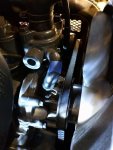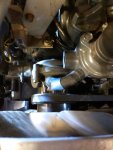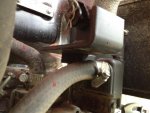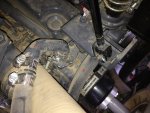NoJacketRequired
Active member
Equipment
B7510 & LA302 FEL & B2782 blower, B7510 & B2781 blower, B2410 & B2550 blower
Am getting ready to plumb the cab heater to the engine. Some posts here have suggested using the thermostat bypass pickoff points. This would be especially handy for me since the specifics of this cab limit me to 3/8" (I.D.) hose.
Questions for the experts... - see photos below, the thermostat bypass hose is, I believe, the one to which I've attached some blue tape
1) if I attach the two heater hoses to the two existing hose nipples (one on thermostat housing, the other on the water pump housing) am I going to get a constant flow of hot coolant going to the heater?
2) which end of this thermostat bypass hose is considered the "pressure" side - the side closest to the pump or closest to the thermostat? I'm assuming I should treat the pump side as the "pressure" side and the thermostat side as the "return" side. Please correct me if this assumption is wrong.
2) the cab has a coolant flow control valve outside the heater core - this valve is sticky and I'm inclined to just leave it permanently in the "on" position. If I do happen to leave the flow control valve functional, should I tee into the hoses and install another valve (perhaps down by the engine) to essentially provide a "winter/summer" selection to ensure the thermostat bypass can continue to flow if I happen to turn off the cab heater valve during the summer?
Thanks for all your helpful guidance. This cab installation is coming along nicely. Once completed I'll start a thread to document the project. Too busy right now trying to actually get the work done to document it!
Questions for the experts... - see photos below, the thermostat bypass hose is, I believe, the one to which I've attached some blue tape
1) if I attach the two heater hoses to the two existing hose nipples (one on thermostat housing, the other on the water pump housing) am I going to get a constant flow of hot coolant going to the heater?
2) which end of this thermostat bypass hose is considered the "pressure" side - the side closest to the pump or closest to the thermostat? I'm assuming I should treat the pump side as the "pressure" side and the thermostat side as the "return" side. Please correct me if this assumption is wrong.
2) the cab has a coolant flow control valve outside the heater core - this valve is sticky and I'm inclined to just leave it permanently in the "on" position. If I do happen to leave the flow control valve functional, should I tee into the hoses and install another valve (perhaps down by the engine) to essentially provide a "winter/summer" selection to ensure the thermostat bypass can continue to flow if I happen to turn off the cab heater valve during the summer?
Thanks for all your helpful guidance. This cab installation is coming along nicely. Once completed I'll start a thread to document the project. Too busy right now trying to actually get the work done to document it!
Attachments
-
89.5 KB Views: 392
-
87 KB Views: 398





